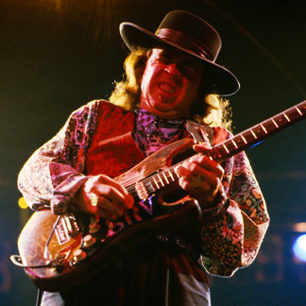
If you’re a fan of Stevie Ray Vaughan, you’ve probably wondered how he gets that unique sound. In this post, we’ll show you how to sound more like SRV and emulate his tone and, (hopefully) play like him. With just a few simple adjustments to your guitar setup and playing style, you can start sounding like one of the greatest blues guitarists of all time. Let’s get started!
For quite some time, I too have been looking for my tone. Like many of us, I’ve searched for the “how to sound like SRV” recipe for almost ever. I’ve been playing for many years and I own gear I worked hard for. I followed all the advice I could soak up, but my tone was just as elusive as that pot of gold at the end of the rainbow.
On some days, my perfect sound was found, and I just needed to improve my playing ability, then on other days, the newly found tone I had recently embraced was thrown out like a cheating girlfriend.
I mean, I was ok with my playing having only taken lessons in my first year of playing many moons ago. I had played onstage to a hundred people and various other family gatherings, played in bars on jam night, but I was by means of comparison to be considered pro.
My chops were good enough that if I got serious about it, I could have made a living playing gigs. But I couldn’t get that prized tone everyone was expecting to hear whenever I showed up with my gear.
It baffled me that a Boss OD-1 was my go-to pedal over the venerable Ibanez TS9 Tube Screamer. This didn’t make sense to me.
So, I started scouring the web to see what SRV’s Tube Screamer set up was. Couldn’t find anything. Went to the forums, where, if you’re patient enough, you’ll find the golden egg, but not always. Fender forums is closed down, unfortunately. The information I found was largely inaccurate except for anything offered by René Martinez, SRV’s long-time guitar tech.
The tone you chase after also can be subject to your mood or setting. How and where an amplifier is placed in a room (or venue) can also greatly affect tone.
So what does a Tube Screamer do?
Basically, the TS-808 is a classic overdrive pedal. Our goal with this article isn’t to understand its features or even how it works. We will rely on our ears and tube screamer settings to get that great SRV tone.
I do know that the circuit design doesn’t use “true-bypass”, but rather a buffered bypass. This means that when the pedal is off, the guitar is still being fed by an input buffer so there will be no tone change to your amp per se.
Since this is an overdrive pedal, our goal is to find settings where we can use this pedal as a boost adding some dirt and gain at low volume levels .
The stock setting on most TS-808s involves limiting the amount of output (volume) which makes sense with SRVs needs; more or less it fits his need for more or less dirt/gain at lower settings through his tube amps without needing too much reverb or echo effectsn’t have an original TS-808 as I am sure most of you don’t either so there is no point in me trying one out. The best thing about pedals is that we can experiment with various ones from different brands and compare them without having to purchase each one outright–hence the reason why Boss pedals are still around today, not because they make amazing sounding effects but because their design allows for easy
I don’t have an original TS-808 as I am sure most of you don’t either so there is no point in me trying one out. The best thing about pedals is that we can experiment with various ones from different brands and compare them without having to purchase each one outright–hence the reason why Boss pedals are still around today, not because they make amazing sounding effects but because their design allows for easy
From my reading and a little bit of research, it became clear to me that SRV used a TS-808 Tube Screamer before he may have used various TS9s and even a TS10.
Will this help me more to sound like SRV?
Regarding chasing that elusive tone that most guitarists look for, much has been said about tone coming from the fingers, the hands, the strings, the pick, the guitar, and eventually, the amplifier. In the 60s, the greats didn’t use effects pedals except perhaps for a wah-wah effect or fuzz. There were also rotating Leslie cabinets, but these weren’t pedals.
When we take up the guitar, many neophytes try to sound like their favourite artist. I mean who didn’t want to sound like Chuck Berry, or Keith Richards, or Jimi Hendrix, or Stevie Ray Vaughan. Regarding the tone being made up of so many components from the fingers right to the amplifier, what makes tone chasing so special is that we forget about the setting and environment on some of our cherished recordings.
So is this the secret to his long sought after tone?
For setting, I don’t mean the knob controls. I mean the studio. Where was that remarkable Layla tone you heard Clapton play on Brownie? What studio? Who was the producer?
Well I found various articles corroborating SRV’s settings. It turns out he didn’t “dial-in” his settings but rather just used the pedal as a boost; a switch. He wasn’t trying to make the tubes scream into his Marshalls. He just needed a little gain at the input. Is this the only way to get to “how to sound like SRV?” No. Again, there’s much in the strings, fingers, soul, and the amp. Well, enough said. Be sure to check out the official SRV site.





Be the first to comment